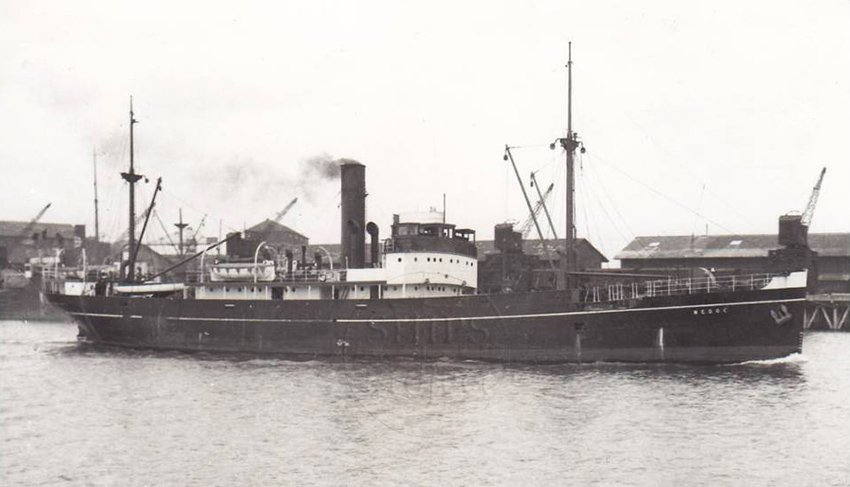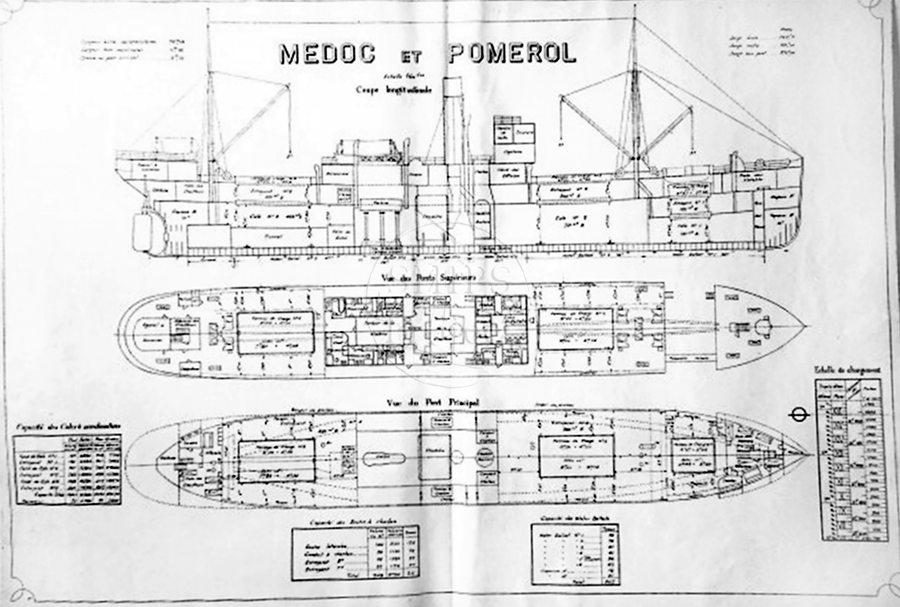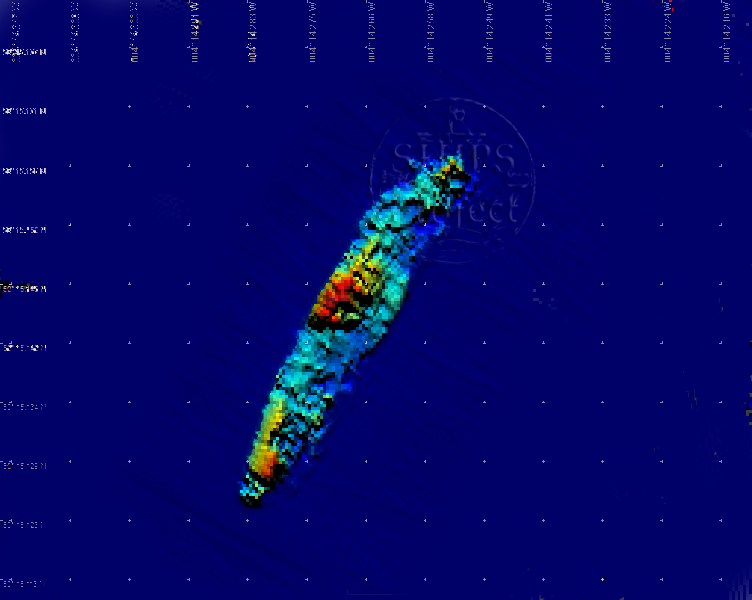FS Medoc
The merchant vessel Medoc was launched on 30th May 1930 at the yard of D. & W. Henderson & Co. Ltd. in Glasgow as yard number 902; she was an 83m long steam coaster, 1166 grt with a 188 hp triple expansion engine and a single boiler, registered number 91452 or 91467. Medoc was built for her owners Worms, Josse & Cie in Le Havre, France, along with her sister the Pomerol, both named after famous wine growing regions. The Medoc was mainly used to ship cargo between Le Havre in France and ports in Scandinavia.
After war was declared in 1939, Medoc was taken in to service by the French as a patrol ship with pennant P24 along with her sister Pomerol as P25. Little is known about her early war service other than she captured a Danish freighter called Helene on 10th April 1940.
As France fell to the invaders the Medoc escaped and found sanctuary in Plymouth. Unsure about the motives of the French government who still controlled their escaped ships safe in English ports, she was boarded by the Royal Navy on 3rd July 1940 to stop the French ships falling into the hands of the Germans. Two weeks later she was given to the Polish Navy who had men but no ships; men who had escaped Poland as the Germans invaded, made their way to England and were determined to fight again. Now the ship was named the OF Medoc, in Polish ‘OF’ means Okręt Francuski or ‘French ship’, so she flew both the French and the Polish national flags. Another change in October put her back in the hands of the Royal Navy and to be known as the training ship FS Medoc. The Polish captain remained on board this French ship with a largely British crew, so she sailed under the three flags of France, Poland and Great Britain.
By November 1940 the FS Medoc had been operating as a British ship for about six weeks. The captain Roman Stankiewicz was Polish but her First Lieutenant William Sobey RNVR was British as were the gunnery officer Lt. Murray RNVR and an RNVR Lieutenant who was the Navigating Officer. There was a Polish midshipman and two Polish ratings but the remainder of the 87 man crew were British. So there was some confusion about her nationality as she is referred to as both FS Medoc and HMS Medoc in the official report on her sinking.
On the evening of 26th November 1940 the Medoc sailed on her last patrol, leaving Devonport in company with the armed trawler HMT Lombard under low cloud and a heavy swell. Medoc was armed with two 100mm guns mounted in front of the accommodation block on platforms over the forward hold plus two more on platforms over the aft hold. One 37mm anti-aircraft (AA) gun was mounted on the forecastle and another on the stern; there were two Hotchkiss and two Mitrailleuse machine guns, two depth charge throwers and 24 depth charges. As usual when on patrol at sea there was a lookout on the port side of the bridge, one on the roof of the bridge and a signalman on watch on the starboard side. At about 6pm one of the lookouts saw a twin engine aircraft approaching on the port side, not knowing if this was a friend or foe he immediately sounded the alarm bell which called the crew to action stations. At the time, both Lt. Sobey and the Polish PO Emyl Moldrzyk were in their cabins, so they quickly rushed up on deck and headed aft to their allotted station by the 37mm AA gun.
The aeroplane was about 500 metres away from the ship and approaching fast when it opened fire with its machine guns and strafed the Medoc. Once he had a clear shot, Moldrzyk opened fire with the Hotchkiss as the plane crossed the bow of the ship and headed away. Having picked his target, the German pilot circled round and headed back towards the ship, he dropped a torpedo into the water and flew away out of range of the guns. The crew on deck could see the torpedo streaking through the water towards them so a few leapt over the side and in to the sea, but Moldrzyk and Sobey stayed at their guns, firing continuously at the aircraft. The hull shuddered violently as the torpedo struck the port side of the ship and exploded, blowing a huge hole in the boiler room and enveloping the whole ship in smoke. Only moments before, both the First Lieutenant and the PO had been secure in the warmth of their cabins but now they were in deadly peril on a rapidly sinking ship: the time between the alarm sounding and the torpedo explosion had been just four minutes.
Sobey’s first thought was about the depth charges so he ordered them to be made safe, the charges were armed and ready when the ship was on patrol so they could explode when they came under pressure if the ship sank to the bottom. That order given, Sobey commanded the crew to abandon ship. The men threw rafts overboard and launched the lifeboats just before the ship lurched violently and her bow went down, tipping the forecastle under water. Moldrzyk jumped over the side, he grabbed a piece of wood floating nearby and paddled over to a raft, climbing on top he dragged another nine sailors and a PO on to it with him.
The armed trawler Lombard that was escorting Medoc saw the explosion so headed to the scene at full speed; Lombard signalled ‘Can I be of assistance to you’ to which the replay from Medoc was simply ‘Help’. Medoc swiftly disappeared beneath the waves as Lombard approached at speed. Suddenly, a severe explosion from deep underwater shook the trawler, her captain prudently steered away when he realised that this was caused by Medoc’s depth charges exploding. It seems that not all of the charges had been made safe and those still armed were detonating when they reached their preset depth. Three more huge explosions followed in quick succession which caused casualties amongst the survivors floating in the water above the wreck. Lombard stood off and picked up three men while waiting for the explosions to stop, before heading for the middle of the floating wreckage and picking up many more. The last man rescued was Lt. Sobey who was nearly missed in the fading light; they got him on board with great difficulty as he was suffering from internal injuries caused by the depth charge explosions underneath him. The first explosion damaged Lombard and caused leaks in the forward hold, but fortunately the damage was not severe as the captain had moved the ship away from above the subsequent explosions.
The only surviving officer from the ship was the First Lieutenant, William Sobey. Of a complement of 87 officers and men, 39 lost their lives including the Polish Commander (1st class) Stankiewicz, Lt. Terence O’Shanohun RNR, T/Lt. Herbert J. Murray RNVR, 36 British ratings, a Polish Midshipman and a Polish Leading Seaman; the casualties are listed at the end of this page.
This was an unusual cause of loss as the majority of aerial torpedo incidents registered by British Air Intelligence in 1940 took place in the North Sea off Northumberland and Scotland, with the sole exception being the sinking of the Medoc. The Medoc was lost on the day before the loss of the armed trawler HMT Elk and only 19 days after the loss of her FNFL sister ship FS Poulmic, both sunk by mines just south of Plymouth Breakwater.
Diving the Wreck
For many years the identity of this wreck was not known so she was called the Halfway Wreck, being half way out to the Eddystone light. First reported as a sonar target by the famous submarine chaser HMS Wild Goose in 1945, she was relocated on a Royal Navy hydrographic survey in 1972. Divers identified her as being the Medoc in 1984 from French made fittings on the binnacle and because some of the letters from her name were still in place on her bow. In 1988 her bell was recovered but she is known more for the large empty brass cartridge cases that could be found in her holds. The Medoc has been a favourite with fishermen for years so the wreck is covered with fishing line and the drapes of trawl net show she has been a target for trawlers too.
The wreck sits upright on the seabed with the shallowest point at 44m in 51m depth. The northern end of the wreck is at 50° 15.157 N 004° 14.254 W and the southern end is 70m away at 50° 15.126 N 004° 14.281 W. The bow reasonably complete with the windlass in place on the forecastle and an anchor on the seabed, the bridge is still largely intact but the holds have slumped inwards. The bell, steam whistle, binnacle and telegraph have been recovered but the 37mm AA gun is still on the stern, now lying on the deck.
The Medoc in peacetime service |
Plans of the Medoc and Pomerol |
3D multibeam sonar image of the Medoc (Plymouth University / SHIPS Project) |
Casualties
Crewmen who lost their lives when the Medoc sank are listed below.
Royal Navy
BALDWIN, John T, Stoker Petty Officer, D/KX 78631
BELL, Charles W, Supply Assistant, D/MX 71565
BRADBURY, Horace, Able Seaman, D/JX 152703
BRICE, Albert J, Ordinary Seaman, D/JX 208288
CAMPBELL, George M, Able Seaman, D/JX 158689
CLIFFORD, William, Stoker Petty Officer, D/K 877
COCKER, William J, Stoker 1c, D/KX 92605
COE, Albert N, Ordinary Seaman, D/JX 206237
DEADY, James, Leading Stoker, D/K 60830
DUNN, Sydney R, Ordinary Seaman, D/JX 214998
GASKELL, John, Ordinary Seaman, D/JX 219901
HANCOCK, John R, Ordinary Seaman, D/JX 169357
HAWKINS, Henry C, Able Seaman, D/JX 136924
KILGALLON, Terrance, Able Seaman, D/JX 154070
MARTIN, Henry G, Able Seaman, D/J 82842
MAY, John, Stoker 1c, D/KX 87935
MEYLER, Thomas G, Ordinary Seaman, D/JX 220004
MOORE, Kenneth S, Ordinary Seaman, D/JX 219951
MORRISH, Thomas I, Ordinary Seaman, D/JX 214851
MURRAY, Herbert J, Ty/Lieutenant, RNVR
MURROW, David, Ordinary Seaman, D/JX 219840
MYHILL, Wilfred A G, Ordinary Seaman, D/JX 199934
NEWTON, George W, Ordinary Seaman, D/JX 219802
O'SHANOHUN, Terence, Lieutenant, RNR
PARKER, Bertie J C, Leading Stoker, D/KX 77111
PREECE, Herbert S, Assistant Cook, D/MX 69478
SHACKLADY, Frederick, Ordinary Seaman, D/JX 219900
SIMKISS, Harry R, Ordinary Telegraphist, D/JX 194179
SIMPSON, John W, Ordinary Seaman, D/JX 187674
SINCLAIR, Robert M, Ordinary Seaman, V/12309 (RCNVR)
SWAIN, Trevor, Supply Assistant, D/MX 67582
THOMAS, Eddie G, Ordinary Seaman, D/JX 208246
WALLACE, Charles R, Assistant Cook, D/MX 68426
WARE, Robert G, Ordinary Seaman, D/JX 208426
WHELAN, Albert, Ordinary Seaman, D/JX 199909
WHITE, Archie T, Ordinary Seaman, D/JX 208307
WOOD, Frederick I, Stoker 1c, D/KX 93876
WOODS, Frederick I, Stoker 1c, D/KX 93876
WORTH, Kenneth J, Ordinary Seaman, D/JX 215019
Polish Navy
KOPCZYNSKI, Edward, Leading Seaman
KRASICKI, Eustachy, Midshipman
STANKIEWICZ, Roman, Commander (1st class)
![]() If you have any more information about this ship then please contact us.
If you have any more information about this ship then please contact us.



